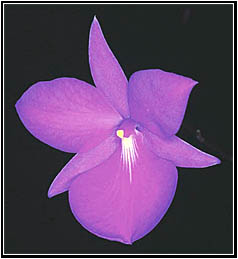
Adamantinia miltonioides
|
The
Discovery of Orchids
An interview with Dr.
Phillip Cribb
|
ON: Dr. Phillip Cribb, the subject of your keynote lecture in Dijon
concerns the discovery of orchid species. We are always astonished with
the high number of species still discovered. How could it be possible?
PC: The tropical forests where most orchids grow
are being rapidly depleted. Travel is also easier. As new roads provide
access to new areas, so new species are discovered. This suggests that
many orchids are rather restricted in their ranges or habitats. The
epiphytic nature of many species also led to species being missed during
surveys, even by specialists.
ON: You said
that news species can reach 500 a year, although the rate is 280. Between
them, which is the number of new genera?
PC: The average number of new species described
each year over the past 20 years is 280 but the range is from 180 to
nearly 500. Some 10 or so new genera are also established each year,
some genuinely new, others splits off large genera.
ON: Most of them
are endemic species?
PC: Many are, others are cryptic species, not
recognised before but lumped into more broadly defined species.
ON: In general,
they are plants with small flowers or also showy flowers?
PC: Obviously, the showier species are better
known but showy novelties are described every year, particularly in
the Andes.
The new Bahian genus Adamantinia(*) is, by any standards, showy.
ON: In what region,
the most part of those new species are found?
PC:Andean South America tops the list, followed
by Central America, SE Asia, and Madagascar.
ON: Among those
new species, hhere are some which are already known under another nomenclature?
PC: No, I am talking only about new species, there
are many new names as well, the result of species being reclassified
in new genera.
ON: Which are
the number of orchid species and genera accepted nowadays? Who has carried
on this study and where it has been published?
PC: The number of new species and genera can be
found in the Monocot Checklist on the Kew website (web address is in
my article). This work has been compiles by Rafael Govaerts at Kew.
The current number of species is just under 25,000 in some 900 genera.
ON: Could you
say that the region situated in the northern Andes of South America
(Peru, Colombia, Ecuador and Venezuela) with their 6437 species is the
most rich region in world?
PC: Yes.
ON: In your lecture
you mentioned the work done by Frodin (2004) and you gave some examples
of the number of species. You said that Bulbophyllum has 1806
species. In your opinion, this genus should be divided? Do you agree
that Cirrhopetalum is a section inside it or should be considered
as another genus?
PC: Currently, Cirrhopetalum is included
in Bulbophyllum. Barbara Gravendeel (Rijksherbarium, Leiden)
and her team are undertaking extensive DNA studies on Bulbophyllum
and its allies. When that is published we should have a better idea
of the generic delimitation in the subtribe.
ON: Do you like
to add something?
PC: The new classification of the orchids by Pridgeon
et al. is being published in six volumes by Oxford University Press.
Three volumes have been published, volume 4 is in press and vols. 5
and 6 are in preparation for completion in 2007.
ON: Thank you,
Phillip
Cribb.
(*) The author
is talking about the new genus described by Van den Berg & C. N.
Gonçalves and published in Orchid Digest having as the species
type Adamantinia miltonioides.
Photo by Cássio
Van den Berg
|
Any
kind of reproduction (print, digital or anyone other) of any
type of material of this site - texts, layout, photos, images
and others - is strictly forbidden without previous written
permission by the authors.
|

|
